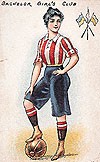| Shrovetide football, as it was called, belonged in the “mob football” category, where the number of players was unlimited and the rules were fairly vague (for example, according to an ancient handbook from Workington in England, any means could be employed to get the ball to its target with the exception of murder and manslaughter).
Shrovetide football is still played today on Shrove Tuesday in some areas, for example, Ashbourne in Derbyshire. Needless to say, it is no longer so riotous as it used to be, nor are such extensive casualties suffered as was probably the case centuries ago. This game is reputedly Anglo-Saxon in origin and there are many legends concerning its first appearance. For example, in both Kingston-on-Thames and Chester, the story goes that the game was played for the very first time with the severed head of a vanquished Danish prince. In Derby, it is said to have originated far earlier, in the 3rd century, during the victory celebrations that followed a battle against the Romans. Despite the legends of Kingston and Chester, certain facts appear to contradict the Anglo-Saxon theory. Namely that there is no evidence of it having been played at this time in Saxon areas or on the continent, nor is the game mentioned in early Anglo-Saxon literature. Prior to the Norman Conquest, the only trace found of any such ball game comes from a Celtic source. One other possible theory regarding its origin is that when the aforementioned “mob football” was being played in the British Isles in the early centuries A.D., a very similar game was thriving in France, particularly in Normandy and Brittany. So it is quite feasible that the Normans brought this form of the game to England with them. All these theories produce a picture quite bewildering in its complexity – far more complex than the simple rules that governed this form of the game, if we dare even to call them rules.
Quite apart from man’s natural impulse to demonstrate his strength and skill, even in this chaotic and turbulent fashion, it is certain that in many cases, pagan customs, especially fertility rites, played a major role. The ball symbolized the sun, which had to be conquered in order to secure a bountiful harvest. The ball had to be propelled around, or across, a field so that the crops would flourish and the attacks of the opponents had to be warded off. A similar significance was attached to the games between married men and bachelors that prevailed for centuries in some parts of England, and, likewise, to the famous game between married and unmarried women in the Scottish town of Inveresk at the end of the 17th century which, perhaps by design, was regularly won by the married women. Women’s football is obviously not so new as some people think. Scholars might have conflicting views on the origins of the game and the influences that certain cults may have had on its evolution, but one thing is incontestable: football has flourished for over a thousand years in diverse rudimentary forms, in the very region which we describe as its home, England and the British Isles. The chain of prohibitions and censures, sometimes harsh, sometimes mild, proves beyond a shadow of a doubt what tremendous enthusiasm there was for football, even though it was so often frowned upon by the authorities. The repeated unsuccessful intervention of the authorities and high offices of the land shows how powerless they were to restrict it, in spite of their condemnation and threats of severe punishment. As long ago as 1314 the Lord Mayor of London saw fit to issue a proclamation forbidding football within the city due to the rumpus it usually caused. Infringement of this law meant imprisonment. King Edward III passed extremely harsh measures in 1331 to suppress football, which was regarded as a public nuisance. At the same time, similar measures were also introduced in France.
During the 100 years’ war between England and France from 1338 to 1453 the court was also unfavorably disposed towards football, albeit for different reasons. Edward III, Richard II, Henry IV and Henry V made football punishable by law because the well-loved recreation prevented their subjects from practicing more useful military disciplines, particularly archery, which played an important and valuable role in the English army at that time. All the Scottish kings of the 15th Century also deemed it necessary to censure and prohibit football. Particularly famous amongst these was the decree proclaimed by the Parliament convened by James I in 1424: “That na man play at the Fute-ball”. None of these efforts had much effect. The popularity of the game amongst the people and their obvious delight in the rough and tumble for the ball went far too deep to be uprooted. The passion for football was particularly exuberant in Elizabethan times. An influence that most likely played a part in intensifying the native popularity for the game came from Renaissance Italy, particularly from Florence, but also from Venice and other cities that had produced their own brand of football known as “Calcio”. lt was certainly more organized than the English equivalent and was played by teams dressed in colored livery at the important gala events held on certain holidays in Florence. It was a truly splendid spectacle. In England the game was still as rough and ungracious and lacking in refinement as ever, but it did at this time find a prominent supporter who commended if for other reasons when he saw the simple joy of the players romping after the ball. This supporter was Richard Mulcaster, the great pedagogue, head of the famous schools of Merchant Taylor’s and St. Paul’s. He pointed out that the game had positive educational value and it promoted health and strength. He claimed that all that was needed was to refine it a little and give it better manners. His notion was that the game would benefit most if the number of participants in each team were limited and, more importantly, there were a stricter referee.
Copyright and Source: FIFA History of the Game |
Soccer History Part 2

















